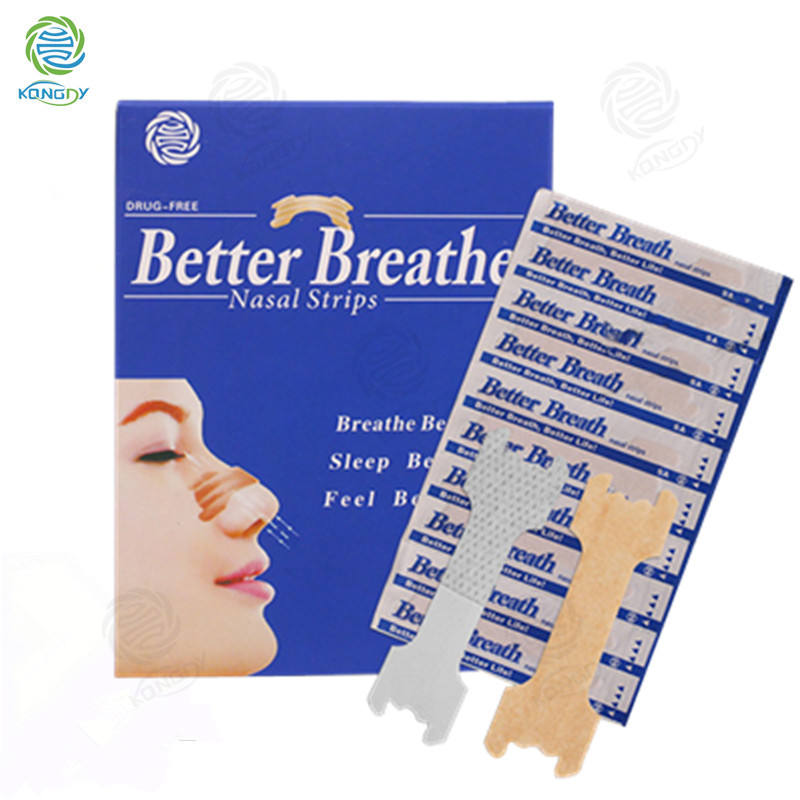Author:Kangdi 21-02-2024
Nasal congestion can be an annoying and uncomfortable condition that makes it difficult to breathe through your nose. It is often caused by inflamed blood vessels lining the nasal passages, which results in swelling and obstruction. Some common causes of nasal congestion include colds, allergies, sinus infections, weather changes, and physical irritants like smoke or dust. For many people, nasal congestion significantly disrupts sleep and everyday activities.
Fortunately, there are some easy and effective solutions that can provide relief for congestion. One popular option is nasal strips. Nasal strips are adhesive strips that go across the bridge of the nose to help open the nasal passages and improve airflow. Here is an overview of how nasal strips work and their benefits for congestion relief:
01. How Nasal Strips Work
Nasal strips contain two key components - an adhesive layer that sticks to the skin and two parallel springs embedded in the adhesive. When applied properly across the bridge of the nose, the springs provide gentle lifting action to open the nasal passages. This lifting action pulls the skin outward, preventing the nasal passages from becoming narrowed or collapsed.
The springs create tension that prevents soft nasal tissues from caving in and blocking airflow. By keeping these tissues more open, nasal strips allow you to breathe easier through your nose. The adhesive holds the springs in place firmly so they continue providing a nasal widening effect throughout the night or daytime use.
02. Benefits of Nasal Strips
Relieve Congestion - By mechanically opening the nasal valves, nasal strips allow more air to flow through congested nasal passages. This results in fast relief from the feeling of a stuffed up nose.
Improve Breathing - Nasal strips make breathing easier when congestion has caused noisy, mouth breathing. The enhanced airflow lets you breathe quietly and comfortably through your nose again.
Reduce Snoring - Nasal congestion narrows the airways, increasing tissue vibration and snoring. Nasal strips widen these airways to decrease snoring frequency and intensity.
Enhance Sleep Quality - Blocked nasal breathing often interrupts sleep. Nasal strips restore restful, uninterrupted sleep by allowing you to breathe properly through your nose all night.
Compatible with Other Treatments - Nasal strips can be used along with other congestion treatments like decongestant sprays, antihistamines, and saline rinses for added relief.
Non-Medicated Relief - Nasal strips provide drug-free congestion relief with no side effects, ideal for pregnant or breastfeeding women. They are also safe for daily use.
Easy Application - Nasal strips apply in seconds with no special tools or complicated techniques required. They can be used at home, work, or while traveling.
Nasal strips come in a variety of styles from major brands like Breathe Right, Walgreens, and CVS Health. They are available in different sizes, materials, and packaging options. Many also contain soothing vapors like menthol and eucalyptus for additional congestion relief. It is a good idea to test different products to find the nasal strip type that fits your nose best and provides the greatest comfort.
03. How to Apply Nasal Strips
Follow these simple steps for proper nasal strip application:
Clean and dry nose - Thoroughly cleanse skin with soap and water, then dry nasal area well. Nasal strips won't adhere properly to oily or damp skin.
Remove backing - Peel off protective backing from adhesive side of nasal strip to expose sticky surface.
Apply to bridge of nose - Place strip adhesive-side down directly onto skin at bridge of nose. Press along entire strip with fingers to secure.
Adjust fit - Gently press ends of strip down along outer nasal passages to achieve a contoured fit. Readjust as needed.
Check strip adhesion - Make sure entire strip is sticking well to nose with no lifting or detached areas. If not sticking, replace with a new nasal strip.
Remove gently - In morning or after use, slowly peel strip off nose. Do not rip strip away abruptly.
Clean skin - Wash any adhesive residue off nose with mild soap and water. Moisturize skin if needed.
Nasal strips are generally effective for providing temporary relief of nasal congestion for up to 10-12 hours as needed. Most brands can be worn comfortably even while sleeping. Make sure to apply nasal strips properly onto clean, dry skin for best results. Position on the bony part of the nose bridge, not further down on the fleshy nasal tip. If nasal strips irritate your skin, try a different brand or allow breaks between usage. Talk to your doctor if congestion persists despite correct use of nasal strips.
 0086 19937104978
0086 19937104978





